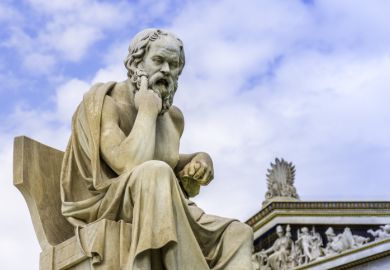David Bostock's translation of and commentary on Aristotle's Metaphysics, Books Z and H comes in the midst of a flurry of publications on the central books of Aristotle's Metaphysics. And yet, there is freshness in Bostock's approach to these books, and novelty in the proposed explanations of what can account for the "unexpected" that enriches the philosophical content of these works.
Every Zeta scholar addresses the problem of the (at least) surface contradictions that Book Zeta of the Metaphysics is committed to as the main challenge in interpreting that work. For Bostock, the internal oppositions in Zeta stem from rewritings of the chapters of this crucial book, resulting from shifts in Aristotle's thought on the most fundamental metaphysical issues he addresses in his system. Bostock detects a shift, in Z, 10-11, from Aristotle's original position that the substantial form is given by the species terms such as man, horse, oak etc, to the position that "the form of a living thing is actually its soul".
The consequence of this shift which, according to Bostock, Aristotle gradually comes to terms with, is that there are universal compounds. Accordingly, Aristotle allows that there can be definition, and hence essence, of compounds such as "pale man". But such compounds are not forms. Yet, if it is the term soul that expresses the form of a human being, and not the species term man, then man, which had formerly been taken by Aristotle as the par excellence universal that has definition and essence, turns out to be a composite, having "soul" as its form. But even as a composite it can still be defined, since composites are defined in a sense, and hence definability does not entail substancehood any more.
In Z, 13, the centre of vexed discussions, Bostock addresses the problem of the mutual claims that no universal is substance, that an essence is a substance, and that essences are universals. Bostock concludes that "there was an earlier version of the chapter in which the species form was counted as a substance, and a later version in which it was not", and that "he never carried out the reconstruction of Z and H that this change of mind so clearly demanded".
Bostock discusses at length the crucial chapter of Z, 17, concentrating on the place of the chapter in Z-H. He sees the arguments in it as establishing the "familiar" conclusion that "the substance of a thing is its form". Bostock does not address the question of how it is that the form brings about unity among the constituents of a substance, and as a consequence, I believe, he does not appreciate the significance of the chapter for showing how the role of the form as a unifier establishes the form as a subject in the substance.
Bostock offers a very good translation of the text (including an interesting rendition of ti en einai as "what-being-is"). He also offers adequate introductions and resumes, which add cohesion, making the exposition "user friendly". The book will prove to be a valuable addition to the Zeta-Eta literature.
David Furley's and Alexander Nehamas's volume of philosophical essays on Aristotle's Rhetoric comes, by contrast with Bostock's Z-H commentary, at the beginning of what seems to be a new wave of interest in rhetoric, Aristotelian or not, picking up from where it left off in the 18th century, before Romanticism abandoned the study of form independently of content, as Nehamas informs us. Our expectations of the volume are therefore enhanced, and it delivers with a series of high-calibre essays.
Miles Burnyeat's article on enthymemes exhibits excellence in scholarship and insight, as it traces the history of definition of this way of reasoning in the Aristotelian tradition. Burnyeat argues that an enthymeme is not an incomplete syllogism, despite Aristotle's definition in the Prior Analytics (which, he shows, must involve corruption of the text), but rather it is a sullogismos. Burnyeat takes us through the history of the Aristotelian text as well as through the treatment of the enthymemes by his commentators. He concludes that "an enthymeme is not a kind of sullogismos, still less a kind of syllogism . . . It is a sullogismos of a kind and a demonstration of a kind", namely enthymemes from likelihoods and from signs. These are "of a kind" because they are not strict deductions, but inferences from what is likely to be the case, and from signs that something is the case.
Eckart Schutrumpf's paper addresses the relation between the introductory chapter of Aristotle's Rhetoric and Platonic texts, showing that questions taken up in it had been the theme of Platonic discussion in the Phaedrus, the Gorgias and the Laws. Furthermore, he offers an explanation of the apparent incompatibility between Aristotle's teaching and practice, namely, that Aristotle eliminates justice as a subject for rhetoric at the beginning of the work, but nevertheless proceeds to instruct how orators should deal with such topics in the rest of the Rhetoric. He explains this incompatibility as a result of the inevitable shortfall between the business of orators in an ideal state, and that in a real, less-than-perfect polis.
John Cooper addresses the thorny question of the subject matter of rhetoric from the point of view of the relationship of the principles of rhetoric to the truths in the political domain. He shows that there are formal principles of rhetoric pertaining to the structures of argumentation, and substantive ones pertaining to the subject matters of ethics and politics. The rhetorician has access to the substantive principle of ethics and politics not through knowledge but through knowing the endoxa, the reputed beliefs in a society, which, for Aristotle, are likely to be the truth. So the rhetorician is different from the ethical or political scientist in that he/she does not have knowledge of the truth. Rather, Cooper explains, the orator acquires the capacity to discern the truth, not through an application of philosophy - which Socrates advocated in the Phaedrus - but through a "genuinely independent art", namely dialectic.
Nehamas focuses on the knowledge status of the orator in an interesting exploration of the cognitive nature of emotions. He uses Aristotle's treatment of emotions in the Rhetoric to elucidate and enhance the account of emotions given in the Poetics. Nehamas addresses the question of the relation of emotions to truth, finding that it is not their cognitive content, but the grounds on which emotions are based, which make them rational and introduce considerations of correctness. Nehamas discusses in particular the Aristotelian exposition of fear and pity in the Rhetoric, and appraises its significance for our understanding of the notion of katharsis in the Poetics.
In the final paper, Andre Laks argues that Aristotle's explicit theory of metaphor (as opposed to his practice) is not as open to interpretation in terms of the cognitive potential of the metaphorical process as has often been assumed. The fact that the passages that establish a link between metaphor and cognition all stem from the Rhetoric is by itself already significant for Laks, who proceeds to analyse the crucial passage of Rhetoric III, 10 and show that it is part of the rhetorical strategy to induce in the listeners quasicognitive processes in which they will take pleasure. In that sense, Laks explains, understanding a metaphor is understanding the lexical substitution (eidos-eidos, eidos-genos, etc.) that is at the bottom of the metaphorical expression, and not understanding something about the nature of the thing itself.
Theodore Scaltsas is reader in philosophy, University of Edinburgh.
Aristotle's Rhetoric: Philosophical Essays
Editor - David J. Furley and Alexander Nehamas
ISBN - 0 691 03232 7
Publisher - Princeton University Press
Price - £37.50
Pages - 322
Register to continue
Why register?
- Registration is free and only takes a moment
- Once registered, you can read 3 articles a month
- Sign up for our newsletter
Subscribe
Or subscribe for unlimited access to:
- Unlimited access to news, views, insights & reviews
- Digital editions
- Digital access to THE’s university and college rankings analysis
Already registered or a current subscriber?



